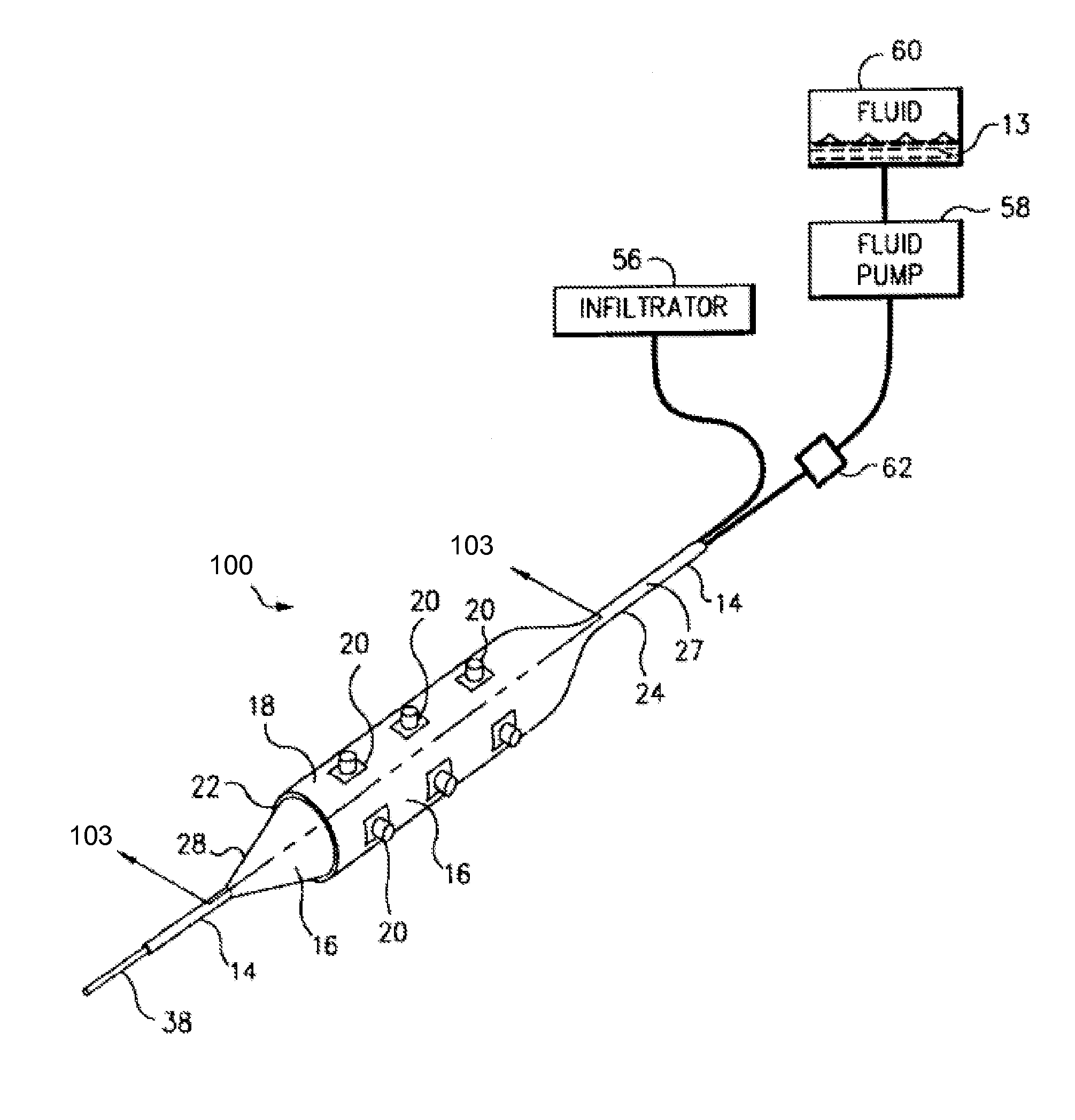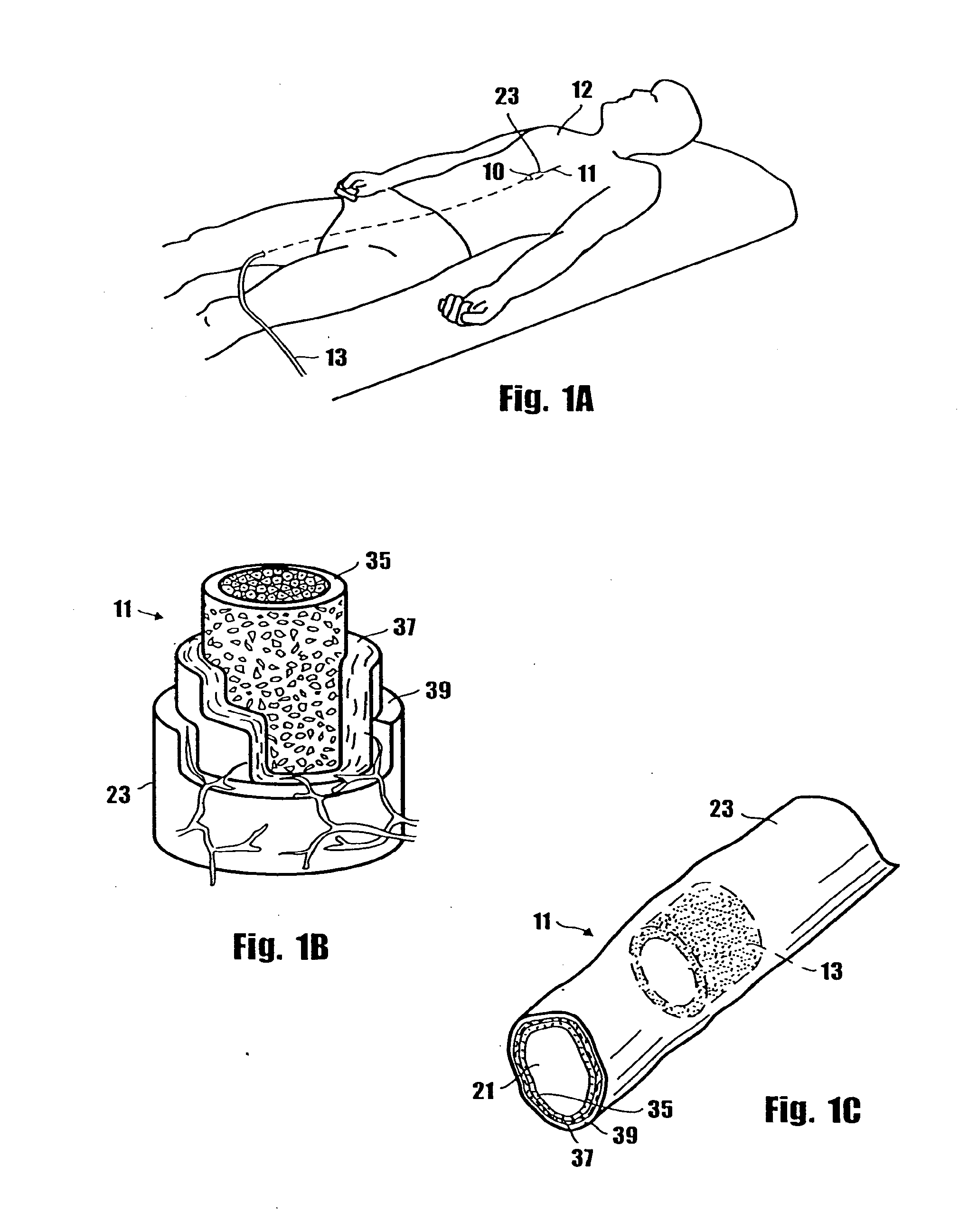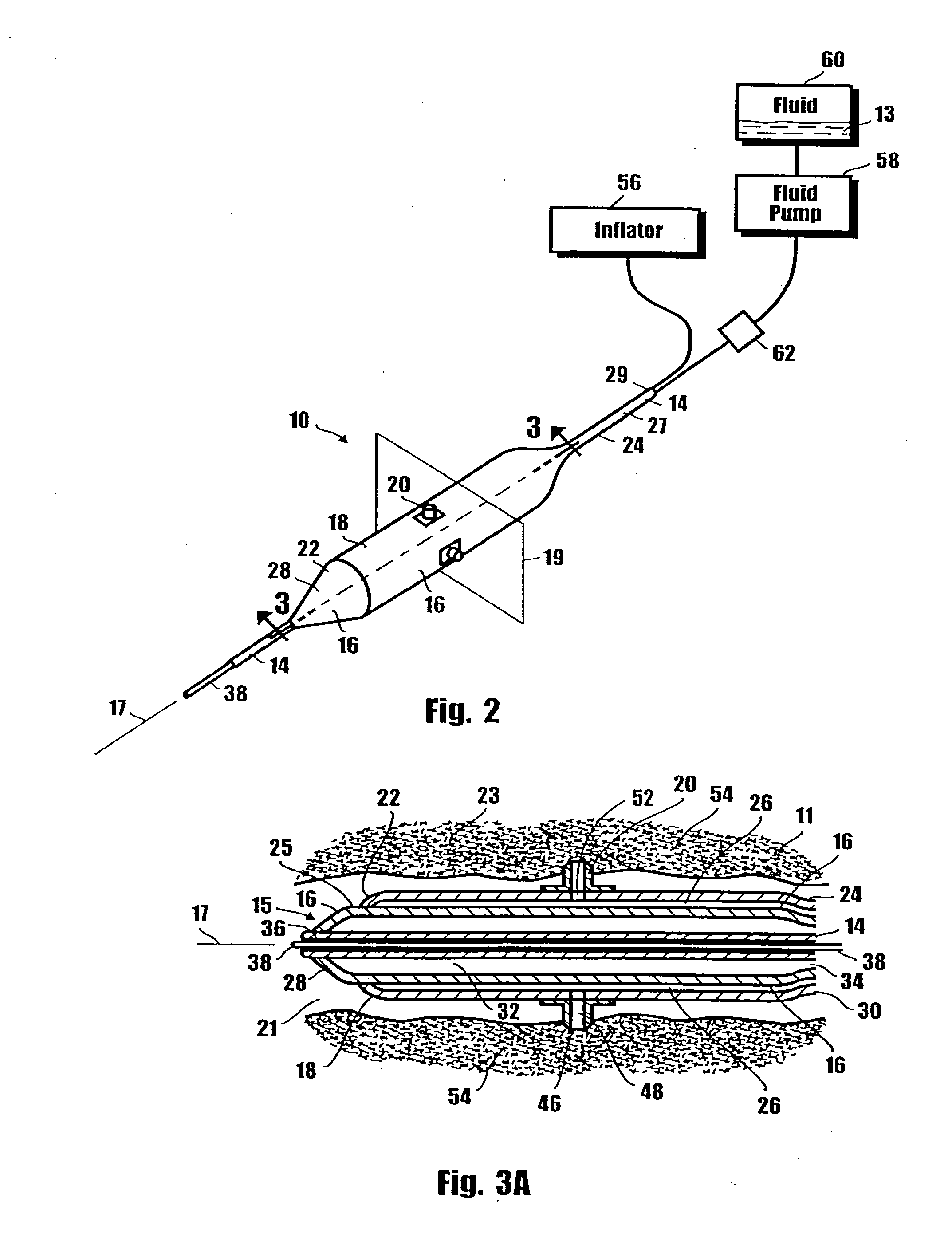Method for delivering medication into an arterial wall for prevention of restenosis
Inactive Publication Date: 2010-06-17
BOSTON SCI SCIMED INC
View PDF71 Cites 49 Cited by
- Summary
- Abstract
- Description
- Claims
- Application Information
AI Technical Summary
Benefits of technology
[0011]The present invention is directed to a method for preventing a restenosis from occurring near the site of an intervascular catheter procedure such as a balloon angioplasty procedure. In accordance with the present method, the restenosis is prevented by medicating a prescribed treatment area within the vessel wall near the site of the angioplasty procedure. For the present method, a medicament known to prevent restenosis is delivered at predetermined locations within the vessel wall and allowed to subsequently disperse thereby medicating the prescribed treatment area. The delivery of the medicament can be accomplished either during the angioplasty procedure or shortly thereafter.
[0014]Once the expanding member is positioned adjacent to the treatment area, it can be activated to force the dispensers into the vessel wall. By the proper design and dimension of the expanding member and dispensers, the dispensers can be made to penetrate to the prescribed vessel layer. Once the dispensers have penetrated the vessel wall to the proper depth, a medicament can be selectively pumped through each dispenser for release at the predetermined locations. Preferably, the dispensers create a plurality of equally spaced localized medicinal deliveries which subsequently disperse to substantially medicate an annulus within the vessel wall. Simultaneously, the expanding member, which may be a balloon, can dilate the lumen of the vessel, thereby producing results similar to the balloon angioplasty procedure described above.
[0015]As provided below, the expanding member selectively and accurately controls the movement of the dispensers, and the medicament source selectively provides a pressurized supply of medicament to the dispensers. Thus, the expanding member mechanism which causes the dispensers to penetrate the vessel wall operates independently from the extracorporeal mechanism for pumping the medicinal fluid to the dispensers, thereby allowing greater freedom in medicinal delivery.
[0016]For the method of the present invention, the expanding member may include a balloon which is expandable from a contracted, first configuration to an expanded, second configuration. Preferably, the dispensers extend radially from the balloon and move with the balloon between the first configuration and the second configuration. This structure allows the dispensers to penetrate into a prescribed target vessel layer such as the intima or media for selective release of a medicament when the balloon is at the second configuration. When properly designed, this structure allows both the depth of penetration of the dispensers into the vessel wall and the force used to penetrate the vessel wall to be precisely controlled.
[0023]Additionally, the active component of the medicament can be designed to have a slow, time-release formulation so that the active component is released to the vessel wall over an extended period of time. Stated another way, the active component can biodegrade slowly over a period of time to gradually release the active component of the medicament into the vessel wall. A biodegradable polymer could be used to provide a control release formulation to the active component.
[0024]Alternatively, the medicament could include a binder secured to the active component of the medicament. The binder binds, attaches or crosslinks to at least a portion of the wall of the vessel. The binder can include a ligand which binds to a portion of the vessel wall such as collagen or the smooth muscle cell component of the vessel wall. This ensures that the bulk of the active component of the medicament remains in the vessel wall and minimizes the amount of the active component of the medicament which is washed away into the blood stream. Examples of ligands binding to the vessel wall components include PDGF receptors, adhesive molecules including, but not limited to certain molecules of the integrin family and receptors on activated platelets such as thrombin receptors. Alternatively, for example, phoshorous tridentate which binds to collagen can be utilized. Further, a binder that has a direct affinity to form ionic bonds, covalent bonds or Van der Waal attractions to the wall of the vessel or some component thereof can be used in the method of the present invention.
Problems solved by technology
Although the angioplasty procedure is generally successful in dilating the lumen of the vessel and thereby allowing increased blood flow through the vessel, often times a restenosis occurs soon after the angioplasty procedure.
Unfortunately, use of the aperture device generally results in an insufficient amount of medicament being delivered to the target area because a large portion of the released medicament does not penetrate the vessel wall, but rather, is washed away into the blood stream.
Further, due to the toxic nature of some of the medicaments used in this procedure, the large portion of medicament entering the bloodstream can cause adverse health effects to the patient.
It is to be appreciated that the use of devices with expanding members and penetrating dispensers will cause some trauma to the vessel wall.
Specifically, as indicated above, dilation of the vessel lumen with a balloon or other expanding member is generally known to cause tissue injury to the vessel wall.
Further, penetration of the vessel wall with a dispenser will certainly cause some injury to vessel wall tissue.
Finally, the release of a medicament within the vessel wall will also cause some injury to the tissue of the vessel wall.
Method used
the structure of the environmentally friendly knitted fabric provided by the present invention; figure 2 Flow chart of the yarn wrapping machine for environmentally friendly knitted fabrics and storage devices; image 3 Is the parameter map of the yarn covering machine
View moreImage
Smart Image Click on the blue labels to locate them in the text.
Smart ImageViewing Examples
Examples
Experimental program
Comparison scheme
Effect test
first embodiment
[0033]FIG. 4A is a perspective view of a first embodiment for a dispenser suitable for use in the present invention;
second embodiment
[0034]FIG. 4B is a perspective view of a second embodiment for a dispenser suitable for use in the present invention;
third embodiment
[0035]FIG. 5A is a side plan view of a dispenser suitable for use in the present invention;
the structure of the environmentally friendly knitted fabric provided by the present invention; figure 2 Flow chart of the yarn wrapping machine for environmentally friendly knitted fabrics and storage devices; image 3 Is the parameter map of the yarn covering machine
Login to View More PUM
 Login to View More
Login to View More Abstract
A method for preventing a restenosis within a vessel wall requires a medicament be delivered at predetermined locations into the vessel wall and allowed to subsequently disperse in a predetermined pattern. To deliver the medicament, a catheter with an expanding member is advanced into the vasculature of a patient until the expanding member is located as desired. The expanding member is then expanded to force dispensers into the vessel wall to the proper depth. A medicament is then pumped through the dispensers to create a plurality of equally spaced, localized medicinal deliveries which subsequently disperse to medicate an annulus shaped volume within the vessel wall.
Description
[0001]This application is a continuation-in-part of application Ser. No. 09 / 232,392, filed on Jan. 15, 1999, which is currently pending. The contents of application Ser. No. 09 / 232,392 are incorporated herein by reference.FIELD OF THE INVENTION[0002]The present invention pertains generally to a method for treating the vessel of a patient. More specifically, the present invention pertains to a medical method for treating a vessel of a patient's cardiovascular system by injecting a fluid directly into the vessel wall. The present invention is particularly, but not exclusively, useful for preventing a restenosis by releasing a medicament at several predetermined locations within the vessel wall to circumferentially disperse the medicament in the vessel wall.BACKGROUND OF THE INVENTION[0003]Angioplasty is a widely used procedure for treating a stenosis within a body vessel such as a human artery. During an angioplasty procedure, a medical catheter having an inflatable balloon attached t...
Claims
the structure of the environmentally friendly knitted fabric provided by the present invention; figure 2 Flow chart of the yarn wrapping machine for environmentally friendly knitted fabrics and storage devices; image 3 Is the parameter map of the yarn covering machine
Login to View More Application Information
Patent Timeline
 Login to View More
Login to View More IPC IPC(8): A61M25/10A61M25/00A61M25/09A61B17/00A61F2/958A61M29/02A61M37/00
CPCA61M25/1002A61M25/104A61M2025/1086A61M2025/105A61M2025/1013A61M37/00
Inventor VIGIL, DENNIS M.REISS, ROBERT E.BARATH, PETER
Owner BOSTON SCI SCIMED INC
Features
- R&D
- Intellectual Property
- Life Sciences
- Materials
- Tech Scout
Why Patsnap Eureka
- Unparalleled Data Quality
- Higher Quality Content
- 60% Fewer Hallucinations
Social media
Patsnap Eureka Blog
Learn More Browse by: Latest US Patents, China's latest patents, Technical Efficacy Thesaurus, Application Domain, Technology Topic, Popular Technical Reports.
© 2025 PatSnap. All rights reserved.Legal|Privacy policy|Modern Slavery Act Transparency Statement|Sitemap|About US| Contact US: help@patsnap.com



